A Novel UWB Positioning Method Based on a Maximum-Correntropy Unscented Kalman Filter
Abstract
1. Introduction
2. UWB Positioning Method Based on Unscented Kalman Filter
2.1. Principle of UWB Positioning
2.2. UWB Location Algorithm Based on the UKF
3. Proposed Algorithm Based on the Maximum-Correntropy UKF
3.1. Principle of Maximum Correntropy
3.2. Proposed Algorithm
- Step 1: Initialize the state vector and the covariance matrix.
- Step 2: State one-step forecast update.
- Step 3: State the one-step prediction mean square error update.
- Step 4: According to Formula (34), update the measurement-noise covariance matrix.
- Step 5: According to Formula (21), update the UKF measurement.
4. Results and Analysis
4.1. Simulation
4.2. Test Verification
5. Conclusions
Author Contributions
Funding
Institutional Review Board Statement
Informed Consent Statement
Data Availability Statement
Conflicts of Interest
References
- Barbieri, L.; Brambilla, M.; Trabattoni, A.; Mervic, S.; Nicoli, M. UWB localization in a smart factory: Augmentation methods and experimental assessment. IEEE Trans. Instrum. Meas. 2021, 70, 2508218. [Google Scholar] [CrossRef]
- Jiang, C.; Shen, J.; Chen, S.; Chen, Y.; Liu, D.; Bo, Y. UWB NLOS/LOS classification using deep learning method. IEEE Commun. Lett. 2020, 24, 2226–2230. [Google Scholar] [CrossRef]
- Jiang, C.; Chen, S.; Chen, Y.; Liu, D.; Bo, Y. An UWB channel impulse response de-noising method for NLOS/LOS classification boosting. IEEE Commun. Lett. 2020, 24, 2513–2517. [Google Scholar] [CrossRef]
- Xu, A.; Liu, T.; Sui, X.; Wang, C.Q. Indoor positioning and attitude determination method of UWB/INS tight combination. J. Navig. Position. 2017, 5, 14–19. [Google Scholar]
- Liu, T.; Xu, A.; Sui, X. UWB indoor location based on adaptive robust Kalman filter. J. Sens. Technol. 2018, 31, 567–572. [Google Scholar]
- Li, R.; Wang, N.; Liu, J. Estimation and compensation method of UWB ranging error for relative navigation. J. Instrum. 2019, 40, 28–35. [Google Scholar]
- Wang, R.; Zheng, S.; Chen, H. An indoor collaborative location method based on Taylor and Kalman. J. Sens. Technol. 2014, 27, 1557–1561. [Google Scholar]
- Cai, G.; Xu, A.; Hong, Z. Robust volume Kalman filtering and its application in UWB indoor positioning. Surv. Mapp. Sci. 2018, 43, 123–129. [Google Scholar]
- Huang, Y.; Zhang, Y.; Li, N.; Wu, Z.; Chambers, J.A. A novel robust Student’s t-based Kalman filter. IEEE Trans. Aerosp. Electron. Syst. 2017, 53, 1545–1554. [Google Scholar] [CrossRef]
- Liu, F.; Li, X.; Yuan, S.; Lan, W. Slip-aware motion estimation for off-road mobile robots via multi-innovation unscented Kalman filter. IEEE Access 2020, 8, 43482–43496. [Google Scholar] [CrossRef]
- Alspach, D.; Sorenson, H. Nonlinear Bayesian estimation using Gaussian sum approximations. IEEE Trans. Autom. Control 1972, 17, 439–448. [Google Scholar] [CrossRef]
- Xu, X.; Zhang, Y.; Ren, M.; Zhang, J.; Yan, G. Generalized correntropy filter-based fault diagnosis and tolerant control for non-Gaussian stochastic systems subject to sensor faults. IEEE Access 2018, 6, 12598–12607. [Google Scholar] [CrossRef]
- Shi, W.; Li, Y.; Wang, Y. Noise-free maximum correntropy criterion algorithm in non-Gaussian environment. IEEE Trans. Circuits Syst. II Express Briefs 2019, 67, 2224–2228. [Google Scholar] [CrossRef]
- Cinar, G.T.; Principe, J.C. Hidden State Estimation Using the Correntropy Filter with Fixed Point Update and Adaptive Kernel Size. In Proceedings of the 2012 International Joint Conference on Neural Networks (IJCNN), Brisbane, QD, Australia, 10–15 June 2012; pp. 1–6. [Google Scholar]
- Huang, Y.; Xue, C.; Zhu, F.; Wang, W.; Zhang, Y.; Chambers, J.A. Adaptive recursive decentralized cooperative localization for multirobot systems with time-varying measurement accuracy. IEEE Trans. Instrum. Meas. 2021, 70, 8501525. [Google Scholar] [CrossRef]
- Liu, X.; Qu, H.; Zhao, J.; Chen, B. Extended Kalman Filter under Maximum Correntropy Criterion. In Proceedings of the 2016 International Joint Conference on Neural Networks (IJCNN), Vancouver, BC, Canada, 24–29 July 2016; pp. 1733–1737. [Google Scholar]
- Cao, Y.; Yang, C.; Li, R.; Knoll, A.; Beltrame, G. Accurate position tracking with a single UWB anchor. In Proceedings of the 2020 IEEE international conference on robotics and automation (ICRA), Paris, France, 31 May–31 August 2020; pp. 2344–2350. [Google Scholar]
- Huang, Y.; Zhang, Y.; Zhao, Y.; Shi, P.; Chambers, J.A. A novel outlier-robust Kalman filtering framework based on statistical similarity measure. IEEE Trans. Autom. Control 2020, 66, 2677–2692. [Google Scholar] [CrossRef]
- Landolsi, M.A.; Muqaibel, A.H.; Almutairi, A.F. UKF-based channel estimation and LOS/NLOS classification in UWB wireless networks. J. Eng. Res. 2016, 4, 15. [Google Scholar] [CrossRef]
- Chen, B.; Wang, X.; Li, Y.; Principe, J.C. Maximum correntropy criterion with variable center. IEEE Signal Process. Lett. 2019, 26, 1212–1216. [Google Scholar] [CrossRef]
- Huang, Y.; Zhang, Y.; Chambers, J.A. A novel Kullback–Leibler divergence minimization-based adaptive student’s t-filter. IEEE Trans. Signal Process. 2019, 67, 5417–5432. [Google Scholar] [CrossRef]
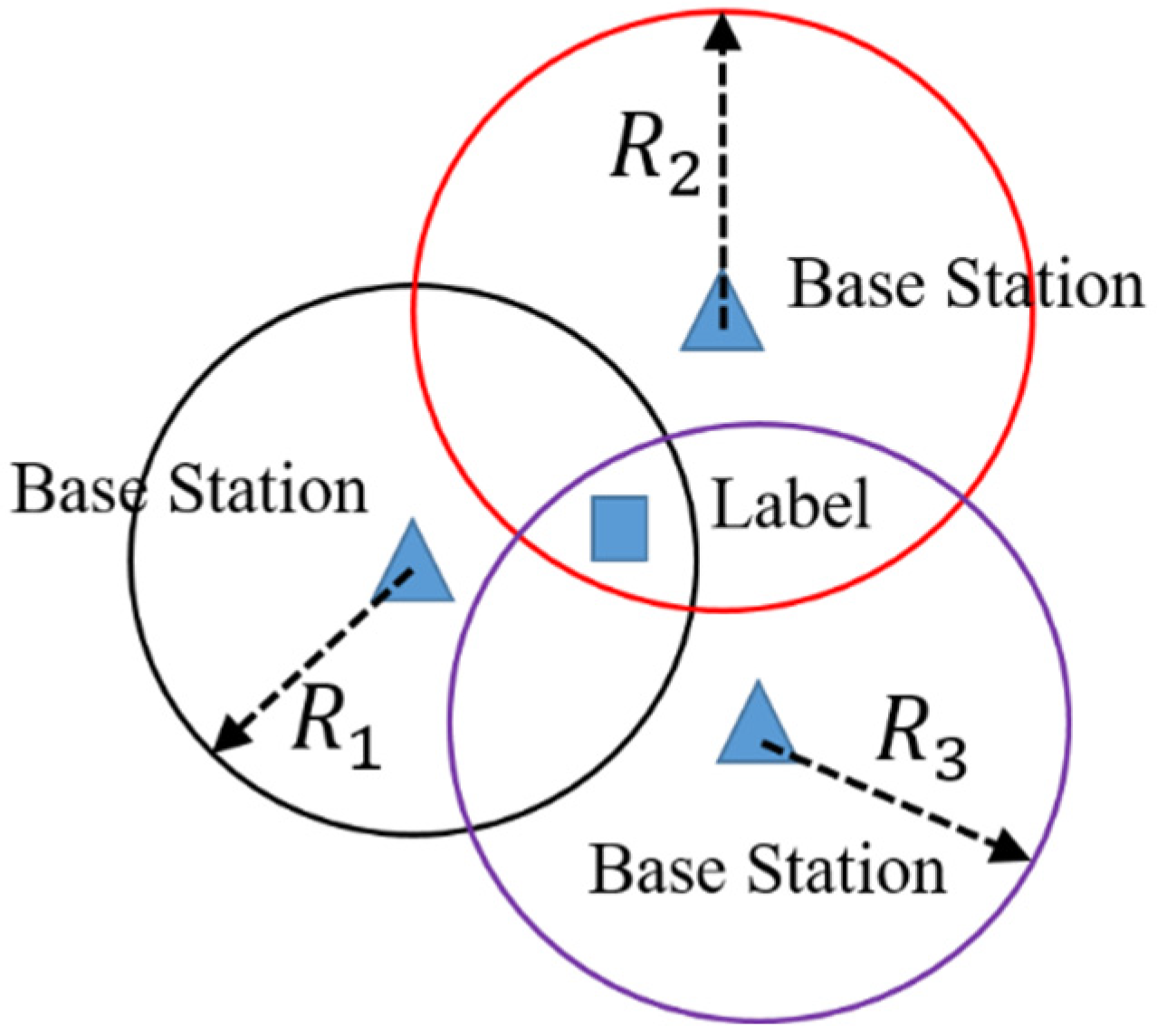
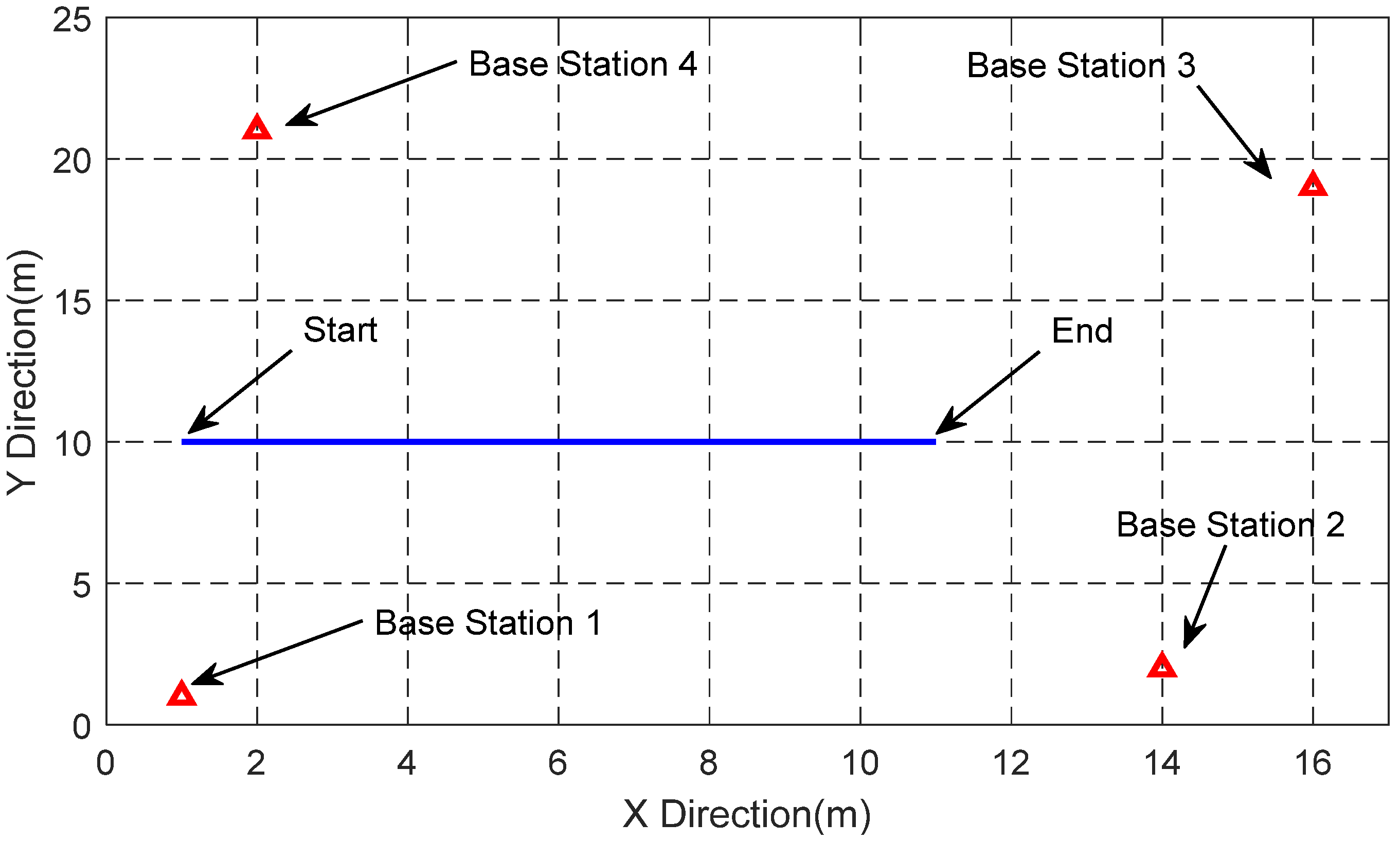



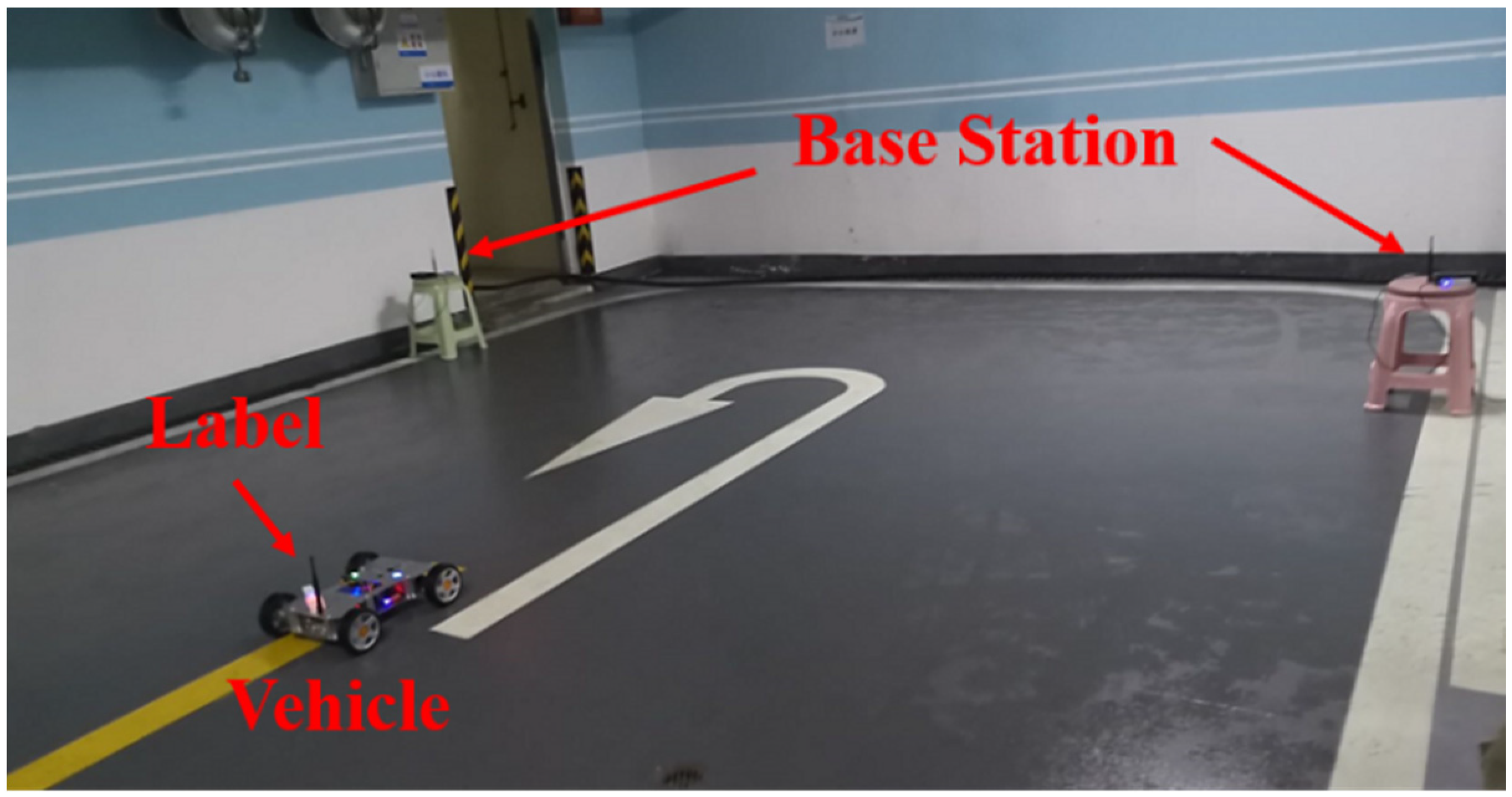


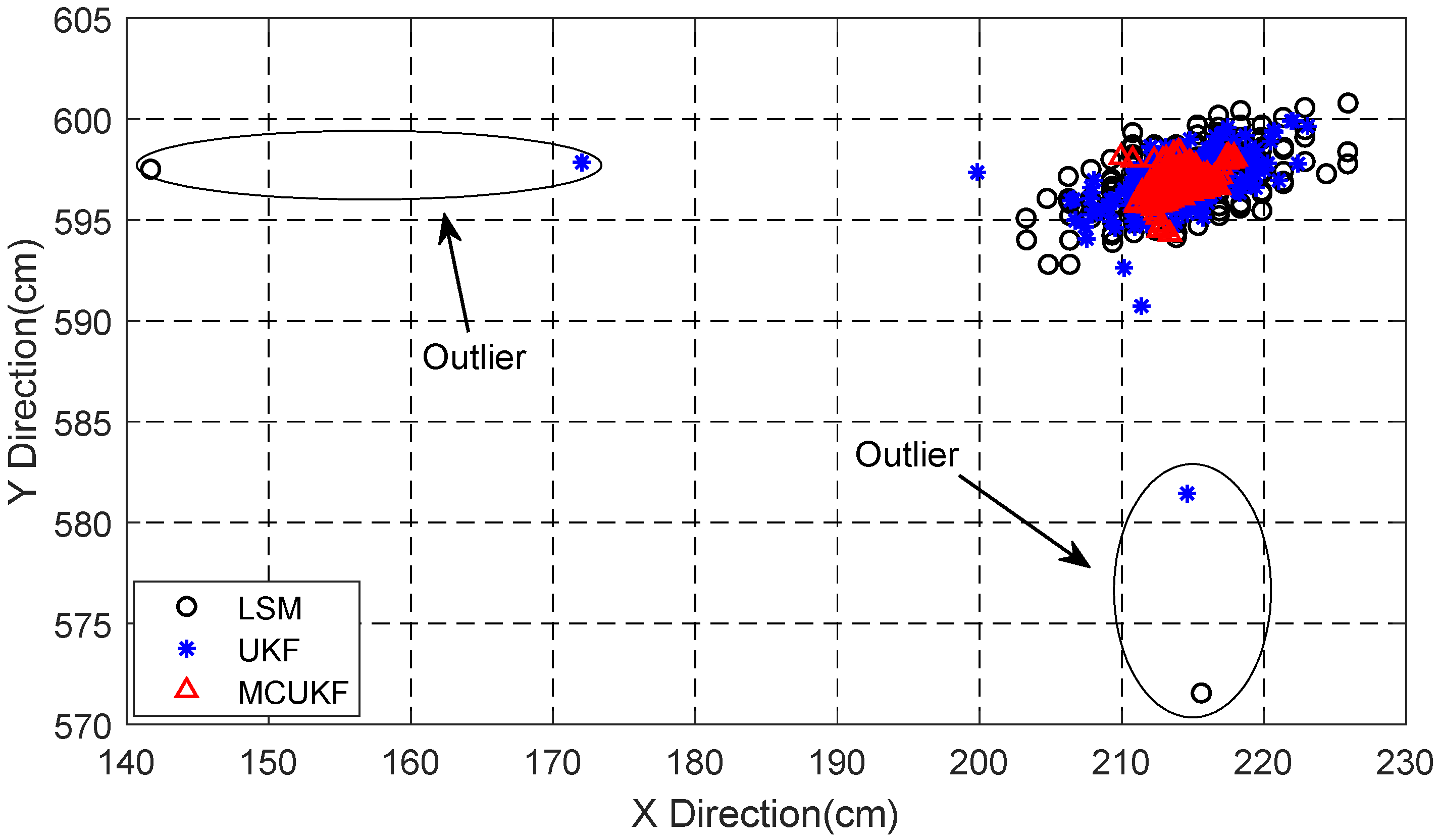
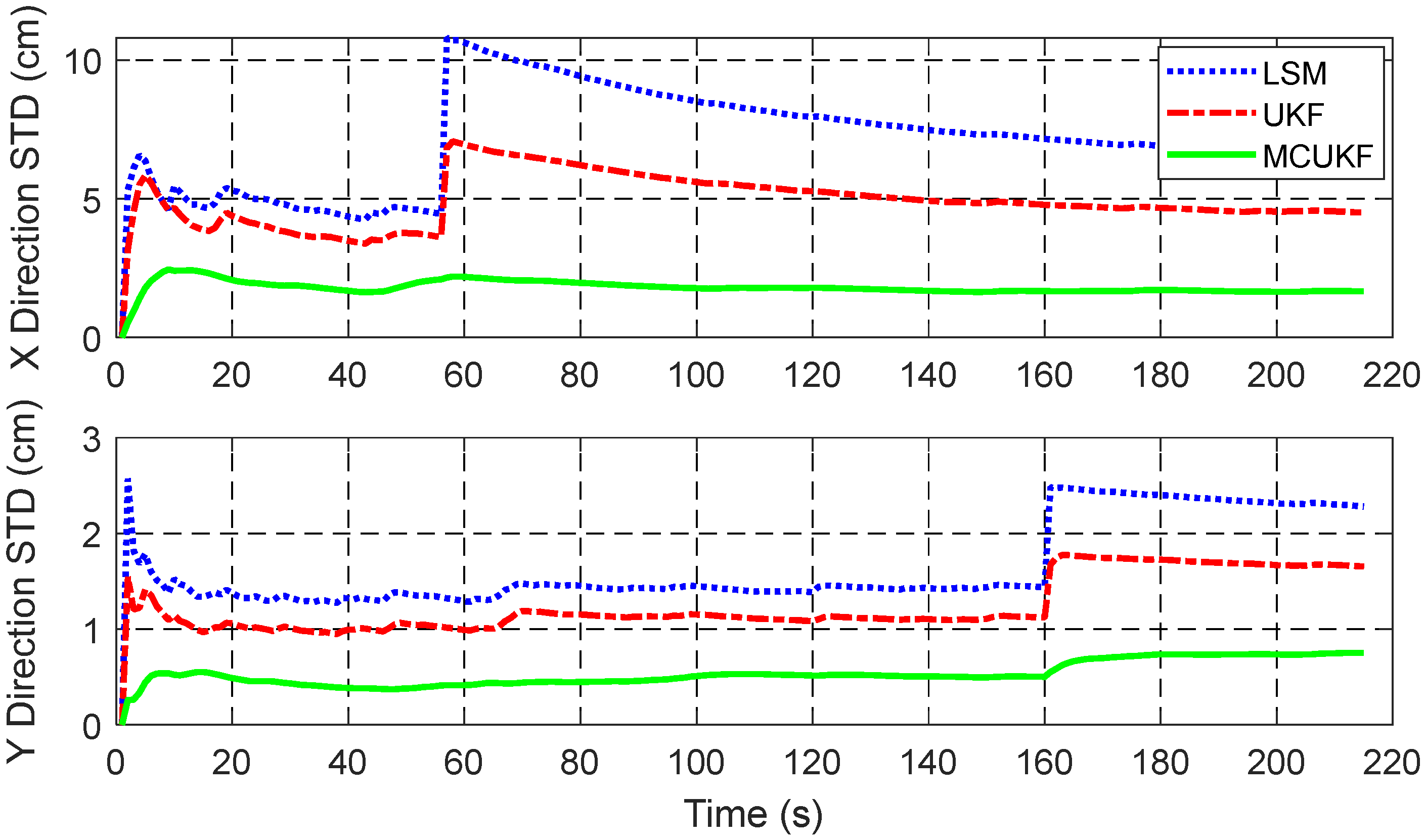

| Method | X-Direction Error (m) | Y-Direction Error (m) | Horizontal Position Error (m) |
|---|---|---|---|
| LSM | 0.1655 | 0.1190 | 0.2038 |
| UKF | 0.1059 | 0.0828 | 0.1372 |
| MCUKF | 0.0753 | 0.0565 | 0.0942 |
| Method | X-Direction Error (m) | Y-Direction Error (m) |
|---|---|---|
| LSM | 5.1034 | 1.8855 |
| UKF | 3.9037 | 1.4531 |
| MCUKF | 1.6075 | 0.7472 |
| Method | X-Direction Error (m) | Y-Direction Error (m) |
|---|---|---|
| LSM | 6.603 | 2.281 |
| UKF | 4.506 | 1.653 |
| MCUKF | 1.661 | 0.752 |
Publisher’s Note: MDPI stays neutral with regard to jurisdictional claims in published maps and institutional affiliations. |
© 2022 by the authors. Licensee MDPI, Basel, Switzerland. This article is an open access article distributed under the terms and conditions of the Creative Commons Attribution (CC BY) license (https://creativecommons.org/licenses/by/4.0/).
Share and Cite
Zhao, M.; Zhang, T.; Wang, D. A Novel UWB Positioning Method Based on a Maximum-Correntropy Unscented Kalman Filter. Appl. Sci. 2022, 12, 12735. https://doi.org/10.3390/app122412735
Zhao M, Zhang T, Wang D. A Novel UWB Positioning Method Based on a Maximum-Correntropy Unscented Kalman Filter. Applied Sciences. 2022; 12(24):12735. https://doi.org/10.3390/app122412735
Chicago/Turabian StyleZhao, Mujie, Tao Zhang, and Di Wang. 2022. "A Novel UWB Positioning Method Based on a Maximum-Correntropy Unscented Kalman Filter" Applied Sciences 12, no. 24: 12735. https://doi.org/10.3390/app122412735
APA StyleZhao, M., Zhang, T., & Wang, D. (2022). A Novel UWB Positioning Method Based on a Maximum-Correntropy Unscented Kalman Filter. Applied Sciences, 12(24), 12735. https://doi.org/10.3390/app122412735







